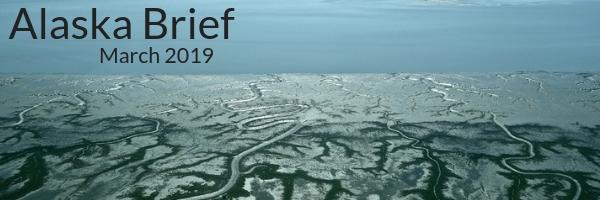Alaska Brief–March 2019

| Cook Inlet stretches 180 miles from the Gulf of Alaska to Anchorage, where it splits like a crab claw into the Knik and Turnagain arms north and south of the city. The road from Anchorage to Kenai and Homer parallels this massive and vital inlet. The inlet’s water defines the lives of those who live in the region–the people who eat fish from its waters, clam at its shores, travel along and across it by land and sea. Yet we forget that what we allow to happen in and around Cook Inlet affects the health of water, fish, whales, and communities throughout southcentral Alaska. When I first worked as an intern for Trustees in 1994, I cut my legal teeth on Cook Inlet. Back then, we were investigating the violations of the oil and gas facilities operating in the inlet since the 1950s and 60s. It was my job to look at years of discharge monitoring reports to figure out how many violations had occurred without EPA doing any enforcement. In the end, it was thousands. The lawsuit that Trustees brought in the mid-1990s resulted in significant penalties for those violations and the seed money to start Cook Inletkeeper. Cook Inletkeeper has been a close ally to Trustees ever since and we still work in tandem to stop pollution in Cook Inlet. Part of that work has been trying to get agencies to require more scientific information about the impacts of decades of pollution. Today, we still lack studies that show what oil and gas drilling has done and is doing to Cook Inlet’s water and wildlife. We got Cook Inlet beluga whales listed as endangered, but still lack agreement (or will) to bring them back to a healthy population. (Their numbers went from 1,300 in the 1970s to just over 300 in the last count.) We still lack a modern wastewater treatment plant. In fact, the Anchorage facility is one of the last in the country allowed to operate without tertiary treatment, the standard requirement under the Clean Water Act to cleanse wastewater before using it for non-potable purposes or discharging it to the environment. Despite the pollutant pressures on Cook Inlet, the Alaska Department of Environmental Conservation wants to rubber stamp a renewed Cook Inlet General Permit for oil and gas facilities that actually makes water quality worse. Remember, this area is home to two-thirds of Alaska residents. It provides the primary food for some people, jobs to others, and the foundation of traditional and cultural ways of life for still others. Instead of demanding and funding research to find out how oil and gas drilling impacts Cook Inlet water, wildlife and communities, the state agency wants to allow the oil and gas industry to use Cook Inlet as an even bigger dumping ground. Keep in mind, Cook Inlet oil and gas facilities are the only facilities in the country not required to meet a “zero discharge” standard in nearshore waters. This loophole allows companies to dump millions of gallons of toxic waste, including oil, drilling fluids, and heavy metals directly into Cook Inlet. Worse yet, the proposed permit would actually increase the sheer volume of waste discharges allowed and open more areas of Cook Inlet to pollution. Oil and gas wastes can bioaccumulate (become more toxic) with each step in the food chain, from plankton to fish to marine animals, birds, and other animals that many Alaskans eat as a primary food. The proposed permit also authorizes oil and gas companies to use what they call “mixing zones” of 1000 meters in length–over half a mile!–where discharges are allowed to exceed water quality standards meant to protect fish and other animals that swim through those waters. Look, we have no shortage of exploitive proposals to pay attention to and prevent right now. This permit is one of them. This proposed permit allows an increase in toxic discharges and goes backward, not forward, in protecting Alaska communities. For example, one of the more recent oil and gas facilities, the Osprey Platform was permitted as a zero-discharge facility because Trustees and Cook Inletkeeper insisted that the new facility meet the requirements of the rest of the country. Yet, now, DEC proposes to allow Osprey to dump waste directly into Cook Inlet, which also would waive the protective buffer required for the Redoubt Bay Critical Habitat Area. It is unacceptable for DEC to give oil and gas a free ride in Cook Inlet, especially at the expense of all the animals and people who rely on Cook Inlet waters. The comment period for speaking out on this proposed permit ends May 22. Please make yourself heard. Send comments through email and go to one of the public hearings next week: Tuesday, March 26 in Homer Wednesday, March 27 in Kenai Thursday, March 28 in Anchorage We need to let the Dunleavy administration know that we expect more, not less, protection for Cook Inlet. |

| PS: Your support of Trustees for Alaska is critical now more than ever. |
Pebble’s big fish story
What could possibly go wrong with a giant industrial mine that produces volumes of toxic stew that has to be stored forever? Let’s start with mine tailings storage: A dam failure would release a toxic sludge into hundreds of miles of salmon streams.
30 years ago, a killing oil
Thirty years ago, the “highly unlikely” happened in Prince William Sound. A giant oil spill altered Alaska forever. Here, Trustees for Alaska board members reflect on the Exxon Valdez oil spill 30 years later.

Come with us to the Arctic!
Come camp and hike, or view polar bears off Barter Island, while learning about the Arctic region and some of the industrial threats to its health.




